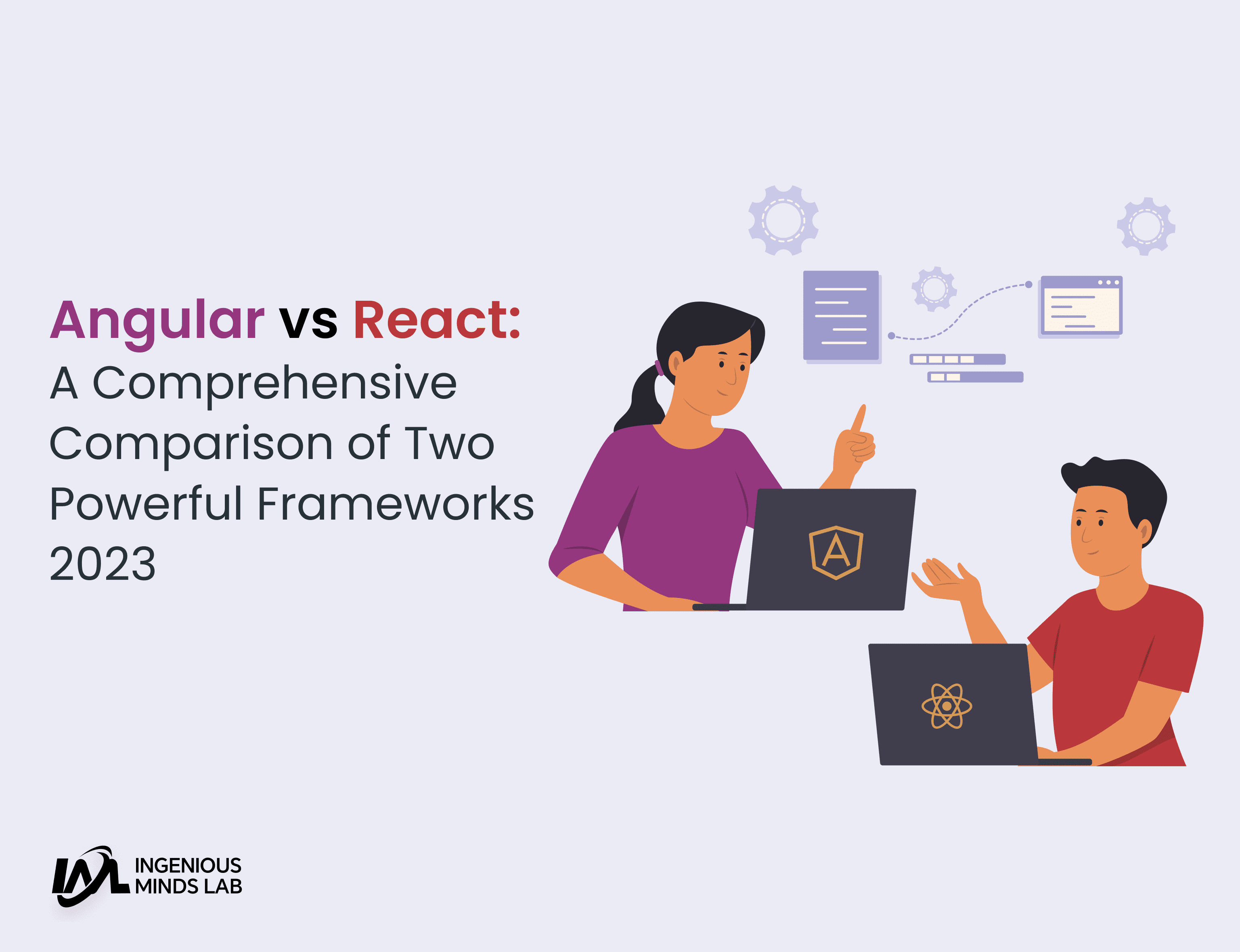Introduction :
In the fast-paced world of web development, staying updated with the latest frameworks and technologies is crucial to building successful applications. Among the vast array of options available, Angular and React have emerged as two dominant frameworks that have revolutionized the way developers approach front-end development. The debate of Angular vs React has sparked intense discussions within the developer community, as both frameworks bring unique features and advantages to the table. In this comprehensive comparison, we will dive into the similarities, differences, and suitability of Angular and React for various business needs.
Angular, developed and maintained by Google, is a comprehensive JavaScript framework that offers a complete solution for building dynamic and scalable web applications. Angular follows the Model-View-Controller (MVC) architectural pattern, providing a structured approach that emphasizes separation of concerns. With Angular, developers can leverage a robust set of features, including two-way data binding, dependency injection, and a powerful Command Line Interface (CLI) for project scaffolding and management. Angular is written in TypeScript, a statically-typed superset of JavaScript, which brings enhanced tooling and better code maintainability.
On the other hand, React, created by Facebook, is a JavaScript library that focuses on building efficient user interfaces. React takes a component-based approach, allowing developers to build reusable UI components and manage the application’s state effectively. One of the core advantages of React is its use of a virtual Document Object Model (DOM), which enables efficient rendering by selectively updating only the necessary components. React’s simplicity and flexibility have made it a popular choice for building interactive user interfaces and single-page applications.
When considering Angular vs React, it’s essential to evaluate the specific needs of your business and project requirements. Angular excels in large-scale applications that demand a high level of structure and organization. Its comprehensive feature set, extensive documentation, and strong community support make it an excellent choice for enterprise-level projects. On the other hand, React’s lightweight nature and efficient rendering mechanism make it ideal for building highly interactive user interfaces and applications with rapid prototyping needs.
Throughout this comparison, we will delve into the architecture, learning curve, performance, ecosystem, and use cases of both Angular and React. By the end, you will have a comprehensive understanding of these powerful frameworks, enabling you to make an informed decision about which one is best suited for your business needs. So let’s embark on this journey of exploring the key differences and strengths of Angular and React, helping you navigate the Angular vs React dilemma and choose the right framework for your next project.
Architecture and Design :
When it comes to creating a blog comparing two powerful frameworks like Angular vs React, it’s important to establish a solid architectural and design foundation. By carefully planning the structure and layout of the blog, we can effectively present the information and highlight the key aspects of the Angular vs React debate.
- Clear and Engaging Structure: The blog should have a clear and logical structure that guides readers through the comparison. Start with a captivating introduction that captures the readers’ attention and provides an overview of the topic. Introduce the focused keyword “Angular vs React” early on to establish the blog’s central theme.
- Subheadings and Sections: Break the content into meaningful sections and subheadings. Each section can focus on a specific aspect of the Angular vs React comparison, such as architecture, learning curve, performance, ecosystem, and use cases. This allows readers to easily navigate the blog and find the information they are most interested in.
- Balanced Comparison: Ensure that the blog offers a fair and balanced comparison of both Angular and React. Present the strengths and weaknesses of each framework objectively, backed by research and reliable sources. Provide examples, use cases, and real-world scenarios to illustrate how each framework excels in different contexts.
- Visual Representation: Incorporate visual elements such as diagrams, charts, or infographics to help explain complex concepts related to the architecture and design of Angular vs React. Visual aids can enhance understanding and engagement, making the content more digestible for readers.
- Consistent Formatting: Maintain a consistent formatting style throughout the blog to improve readability. Use bullet points, numbered lists, or tables to present information concisely. Break up longer paragraphs into smaller, more digestible chunks to avoid overwhelming readers.
- Relevant Code Samples: Include relevant code samples or snippets to demonstrate key concepts and features of Angular and React. This can help readers grasp the syntax and get a sense of how the frameworks are used in practice. Ensure the code samples are clear, properly formatted, and aligned with industry best practices.
- Conclusion and Call-to-Action: Summarize the main points of the blog in a concise conclusion, reiterating the key differences and strengths of Angular and React. End the blog with a call-to-action, inviting readers to share their thoughts, ask questions, or explore additional resources on the topic.
By following these architectural and design principles, we can create a blog that effectively presents the Angular vs React comparison, engages readers, and helps them make informed decisions about these powerful frameworks.
Learning Curve of the Angular vs React :
When writing a blog comparing Angular vs React, it’s important to consider the learning curve associated with both frameworks. Understanding the learning curve can help readers gauge the amount of time and effort required to become proficient in either Angular or React. Let’s explore the learning curve of these frameworks in the context of the Angular vs React blog.
- Angular’s Learning Curve: Angular has a steeper learning curve compared to React. This is primarily due to its comprehensive nature and the usage of TypeScript. TypeScript is a statically-typed superset of JavaScript, which introduces additional concepts and syntax that developers need to learn. However, once developers grasp the core concepts and conventions of Angular, it provides a structured and scalable development environment.
To navigate Angular’s learning curve effectively, developers should invest time in understanding the architecture, components, modules, and the various features it offers. Learning TypeScript and the Angular CLI (Command Line Interface) are also important aspects of mastering Angular. The Angular documentation, tutorials, and online courses can be valuable resources to aid in the learning process.
- React’s Learning Curve: React, on the other hand, has a relatively easier learning curve, especially for developers already familiar with JavaScript. React’s simplicity and straightforward syntax make it more accessible to newcomers. The core concept of building reusable UI components is easy to grasp, allowing developers to quickly start prototyping and building applications.
To become proficient in React, developers should focus on understanding React’s component-based architecture, JSX syntax, and the concept of the virtual DOM. Additionally, learning how to manage state effectively using libraries such as Redux or React’s built-in state management tools is essential. The React documentation, online tutorials, and interactive coding exercises can help developers get up to speed with React quickly.
- Continuous Learning and Updates: It’s important to note that both Angular and React are evolving frameworks, with new features and updates being introduced regularly. This means that developers need to embrace continuous learning to stay up to date with the latest best practices, improvements, and changes in the frameworks. Keeping an eye on official documentation, developer communities, and attending relevant conferences or meetups can help developers stay informed and continue to enhance their skills.
Conclusion: While Angular’s learning curve is relatively steeper due to its comprehensive nature and TypeScript usage, React offers a more accessible entry point for developers already familiar with JavaScript. Both frameworks require dedication and practice to become proficient, but the investment in learning is worthwhile as they are widely adopted in the industry and have vibrant communities that offer support and resources.
In the context of the Angular vs React blog, acknowledging the learning curves of both frameworks provides readers with insights into the initial challenges they might face and helps them prepare for their learning journey. By investing time and effort in learning Angular or React, developers can unlock the full potential of these powerful frameworks and leverage their capabilities to build modern, scalable web applications.
Performance :
When it comes to the performance of the Angular vs React blog itself, there are several factors to consider that can impact the user experience and overall efficiency.
- Page Load Speed: The loading speed of the blog plays a crucial role in user engagement and search engine rankings. Both Angular and React offer optimizations to improve page load times. Angular’s ahead-of-time (AOT) compilation and React’s virtual DOM contribute to faster initial rendering, reducing the time it takes for the blog to load and be accessible to readers.
- Responsiveness: A highly responsive blog enhances the user experience, allowing readers to navigate through the content smoothly. React’s efficient rendering mechanism and component-based architecture enable quick updates and ensure that changes in the user interface are reflected promptly. Angular’s comprehensive features and performance optimizations also contribute to a responsive blog experience.
- Scalability: As the Angular vs React blog attracts more visitors and grows in content, scalability becomes crucial. Angular’s robust architecture and optimization techniques, such as tree shaking and lazy loading, help maintain performance even as the blog expands. React’s component-based approach allows for easy management and scaling of the blog’s UI components, ensuring smooth performance regardless of the content size.
- Mobile Optimization: With an increasing number of users accessing content on mobile devices, optimizing the blog’s performance for mobile platforms is essential. Both Angular and React provide tools and techniques to build mobile-friendly applications. Angular’s responsive design capabilities and React’s lightweight nature contribute to a mobile-responsive blog that loads quickly and provides a seamless experience across devices.
- SEO Considerations: Performance is a crucial factor in search engine optimization (SEO). Search engines favor websites and blogs that load quickly and provide a good user experience. By ensuring that the Angular vs React blog performs well, loads efficiently, and is highly responsive, it increases the chances of better search engine rankings and improved visibility.
Conclusion: Addressing the performance aspects of the Angular vs React blog is vital to ensure a positive user experience and effective search engine optimization. By leveraging the performance optimizations offered by Angular and React, such as AOT compilation, virtual DOM, and component-based architecture, the blog can provide fast page load times, responsiveness, scalability, mobile optimization, and SEO-friendly performance. By optimizing the performance of the blog itself, it sets a good example of how Angular and React can be utilized to create high-performing web applications.
Ecosystem and Community :
When writing a blog comparing Angular and React, it’s important to consider the ecosystem and community surrounding both frameworks. The ecosystem and community play a significant role in the development process, providing resources, support, and opportunities for collaboration. Let’s explore the ecosystem and community aspects of Angular and React in the context of the Angular vs React blog.
- Angular Ecosystem and Community: Angular has a robust ecosystem backed by Google, making it a well-established framework with extensive resources and tools. The Angular ecosystem offers:
a. Official Documentation: Angular provides comprehensive and up-to-date documentation that covers every aspect of the framework, including tutorials, guides, and API references.
b. Angular CLI: The Angular Command Line Interface (CLI) is a powerful tool that simplifies project scaffolding, code generation, and build processes, enhancing developer productivity.
c. Third-Party Libraries and Packages: Angular benefits from a wide range of third-party libraries and packages developed by the community, extending the capabilities and functionality of Angular applications.
d. Community Support: The Angular community is active and vibrant, with numerous online forums, discussion groups, and social media channels. Developers can seek help, share insights, and collaborate with other Angular enthusiasts.
- React Ecosystem and Community: React has a thriving ecosystem supported by Facebook and a passionate community of developers. The React ecosystem offers:
a. React Documentation: React’s official documentation is comprehensive and beginner-friendly, providing clear explanations, tutorials, and examples to help developers get started and dive deeper into React concepts.
b. Create React App: Create React App is a command-line tool that sets up a React project with minimal configuration, enabling developers to quickly start building React applications.
c. NPM and Yarn: React leverages the extensive ecosystem of NPM (Node Package Manager) and Yarn, allowing developers to easily integrate third-party libraries and packages into their React projects.
d. React Native: React Native, a framework built on top of React, enables developers to build mobile applications using JavaScript and React. This extends the reach of React to mobile app development, providing a seamless development experience.
e. Supportive Community: The React community is known for its strong support and active engagement. Developers can participate in online forums, React-specific conferences, and local meetups to connect with fellow React enthusiasts and exchange knowledge.
Conclusion: Considering the ecosystem and community aspects of Angular and React is essential when writing the Angular vs React blog. Both frameworks have thriving ecosystems and supportive communities, providing extensive documentation, tools, third-party libraries, and opportunities for learning and collaboration. By tapping into these resources, developers can enhance their understanding, expand their skills, and find solutions to challenges they encounter while working with Angular or React.
Use Cases :
The Angular vs React blog serves as a valuable resource for developers, businesses, and decision-makers who are evaluating the two popular JavaScript frameworks. By exploring various use cases, the blog caters to a wide range of readers seeking guidance on selecting the right framework for their specific needs. Let’s delve into some common use cases where the Angular vs React blog can be particularly beneficial.
- Choosing the Right Framework: The blog helps developers and businesses decide whether to opt for Angular or React based on their project requirements, team expertise, scalability needs, and performance considerations. It provides insights into the strengths, weaknesses, and unique features of each framework, assisting readers in making an informed decision.
- Performance Evaluation: The Angular vs React blog analyzes the performance characteristics of both frameworks, shedding light on factors such as page load speed, responsiveness, scalability, and mobile optimization. This information is valuable for readers seeking to optimize their web applications or improve the user experience based on performance considerations.
- Learning Resources: The blog serves as a learning tool, providing readers with an overview of the learning curve associated with Angular vs React. Developers who are new to either framework can benefit from understanding the resources, documentation, and support available to help them master Angular or React effectively.
- Project Migration: For businesses or developers considering migrating their existing projects from Angular to React or vice versa, the blog offers insights into the challenges, benefits, and considerations involved in such transitions. It helps readers understand the key differences between the frameworks, making it easier to evaluate the feasibility and potential impact of a migration.
- Industry Trends and Insights: The Angular vs React blog keeps readers up to date with the latest industry trends, updates, and advancements in both frameworks. It offers an opportunity for readers to gain insights into real-world use cases, best practices, and case studies that highlight the successful adoption of Angular or React in various projects.
Conclusion: The Angular vs React blog caters to a diverse set of use cases, providing valuable information and insights for developers, businesses, and decision-makers. Whether it’s choosing the right framework, evaluating performance considerations, seeking learning resources, considering project migration, or staying updated on industry trends, the blog acts as a comprehensive guide for readers looking to navigate the Angular vs React landscape. By addressing these use cases, the blog equips readers with the knowledge and understanding necessary to make informed decisions and succeed in their Angular or React projects.






 Subscribe
Subscribe